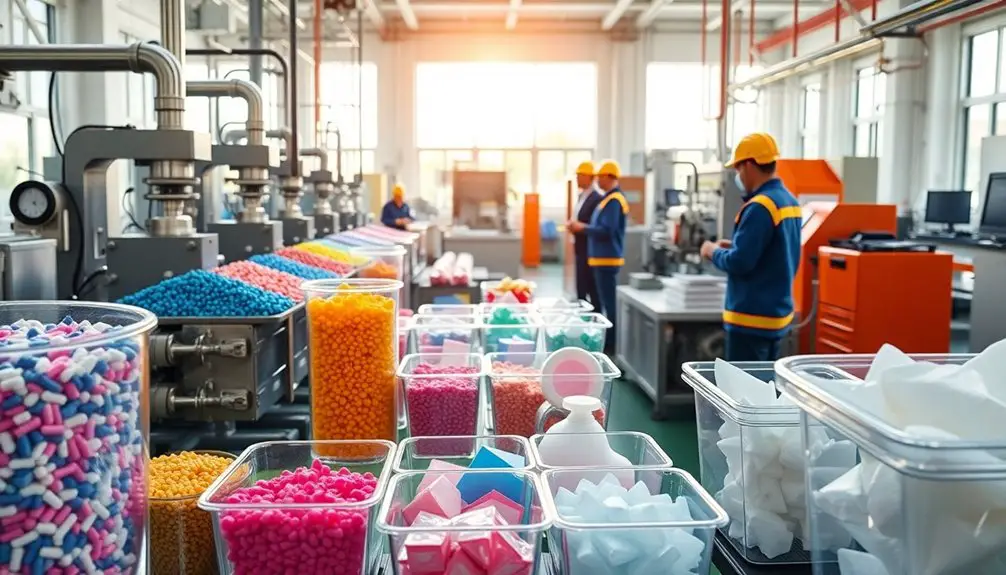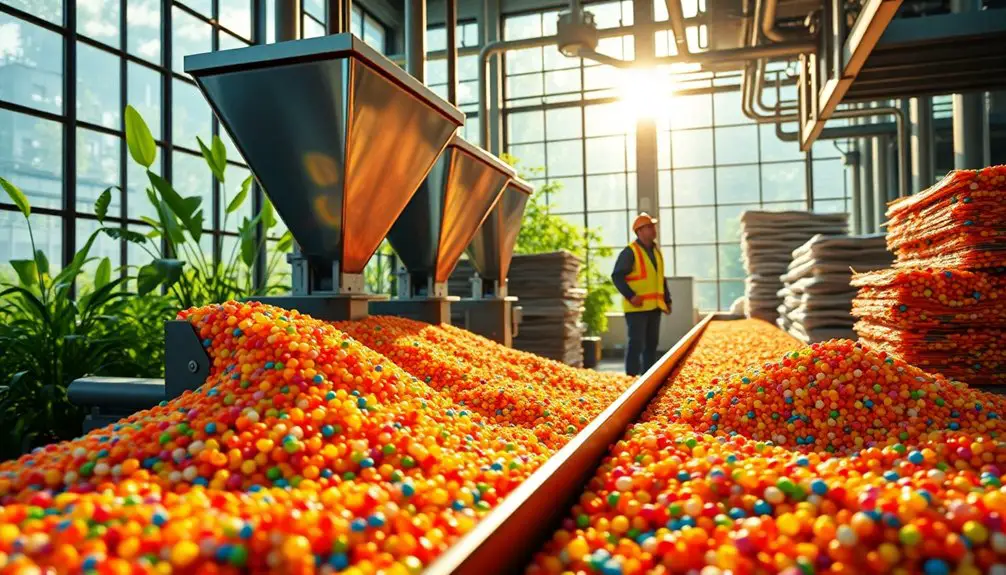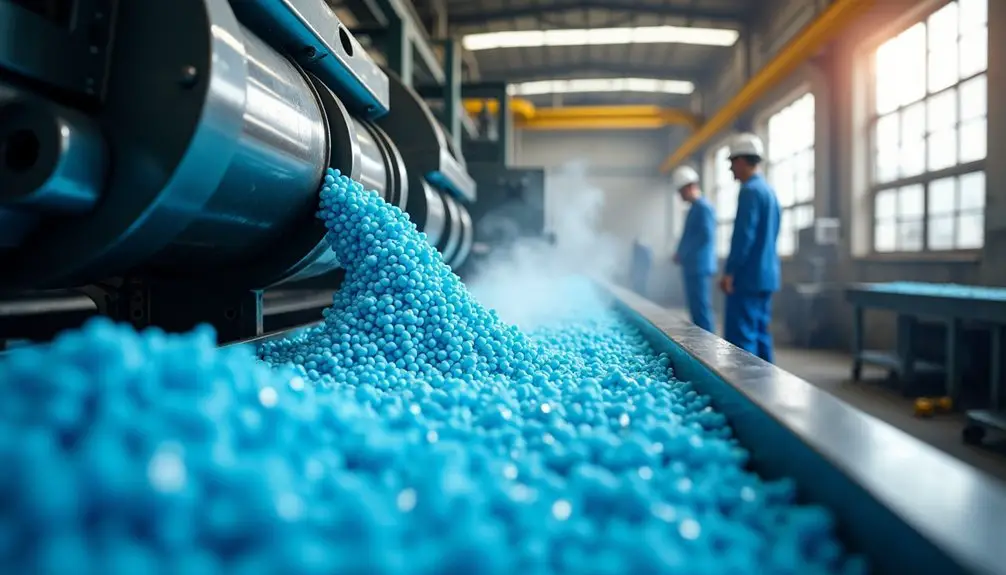To make polypropylene products, you start with polymerization using methods like Ziegler-Natta or metallocene catalysis. These processes use specific catalysts and conditions to create the polymer. Once the polypropylene is formed, it's processed using techniques like injection molding or extrusion. Injection molding shapes it into specific forms at high temperatures, while extrusion allows for continuous shapes. Depending on your needs, you can choose from homopolymers for strength or copolymers for flexibility. This versatile material finds applications in packaging, automotive parts, and more. If you're curious about specific processes or applications, you'll uncover even more interesting details ahead.
Key Takeaways
- Polypropylene products are primarily made through polymerization methods, mainly Ziegler-Natta and metallocene catalysis, to create the desired polymer structure.
- The manufacturing process involves heating polypropylene pellets to high temperatures (200°C to 300°C) for processing methods like injection molding or extrusion.
- Injection molding shapes molten polypropylene into specific designs, while extrusion forms continuous shapes like sheets or pipes.
- Homopolymers provide high rigidity, while copolymers offer flexibility, influencing the choice of material based on application needs.
- Post-production, polypropylene products can be recycled, although the current recycling rate is low, highlighting the need for improved waste management practices.
Overview of Polypropylene
Polypropylene, known for its versatility and strength, is a low-density thermoplastic polymer made from the polymerization of propene. First commercialized in 1957, polypropylene (PP) has become the second most manufactured plastic worldwide. Its high chemical resistance makes it suitable for a wide range of applications, from packaging materials to automotive parts, ensuring durability and performance in various environments.
With a melting point ranging from approximately 160°C to 220°C, PP can withstand high-heat applications without compromising its integrity. This characteristic, combined with its lightweight properties, with a density between 0.898 to 0.908 g/cm³, makes it one of the lightest commodity plastics available.
Additionally, polypropylene is classified under recycling code #5, which indicates it's recyclable. However, the recycling rate for PP remains lower compared to other plastics, presenting an opportunity for improvement in sustainability practices. In terms of its recyclability, the low recycling rate of PP, around 1% in some regions, highlights the need for better waste management systems and increased consumer awareness.
Manufacturing Processes
Several key manufacturing processes contribute to the production of polypropylene, each offering unique advantages. The primary methods for polymerization are Ziegler-Natta and metallocene catalysis.
With the Ziegler-Natta process, titanium-based catalysts operate under specific temperatures and pressures, ensuring high-quality polypropylene suitable for various applications. On the other hand, metallocene catalysis allows for the creation of polypropylene with tailored microstructures, enhancing performance characteristics.
Once you've synthesized the polypropylene, common processing techniques come into play, notably injection molding and extrusion.
Injection molding is particularly favored for its efficiency and ability to produce complex shapes quickly. During this process, the typical processing temperature ranges from 200°C to 300°C, which helps the material flow properly into molds, ensuring consistent product quality.
Extrusion is another effective method, where polypropylene is forced through a die to create continuous shapes, such as sheets or films. As polypropylene is Code 5 (PP) gaining acceptance in recycling, it's crucial to ensure the production process allows for recyclability and minimizes waste.
Properties and Types

Frequently used in various industries, polypropylene (PP) comes in several types, each designed with unique properties to meet specific application needs. The main categories include homopolymers and copolymers.
Homopolymer polypropylene is known for its high rigidity and tensile strength, making it ideal for applications in packaging and automotive components. It typically exhibits a tensile strength at break of 20–40 MPa and elongation at break ranging from 15% to 600%.
On the other hand, copolymers, which include random, block, and impact copolymers, provide increased flexibility and toughness. These variants have lower melting points, ranging from 135–159°C, which affects their processing capabilities. Impact copolymers can achieve elongation at break up to 700%, making them suitable for more demanding applications.
Polypropylene's density ranges from 0.898 to 0.908 g/cm³, contributing to its reputation as one of the lightest commodity plastics. This low density allows you to reduce overall product weight without sacrificing performance.
Understanding these properties enables you to select the right type of polypropylene for your specific needs, enhancing the effectiveness of your products. Additionally, polypropylene's properties can be compared to those of other plastics, such as High-Density Polyethylene (HDPE), to determine the most suitable material for a particular application.
Applications and Uses
The versatility of polypropylene (PP) makes it a go-to material across various industries. Its unique properties enable a wide range of applications that benefit both manufacturers and consumers alike. Here are three key areas where polypropylene shines:
- Packaging: PP is widely used in flexible films and rigid containers, thanks to its excellent barrier properties and strength, making it ideal for food storage and safety.
- Automotive: In the automotive industry, PP is utilized for lightweight components, such as battery cases and bumpers, contributing to improved fuel efficiency and performance.
- Medical: The medical sector benefits from PP's chemical resistance and sterilization capabilities, allowing it to be used for disposable syringes and medical vials.
Beyond these applications, polypropylene is prevalent in consumer goods, like toys and furniture, due to its durability and low cost.
It's also employed in industrial settings for manufacturing chemical tanks and pipes, showcasing its strength and resistance to various chemicals.
With its diverse applications, polypropylene continues to support innovation across multiple sectors, making it an essential material in modern manufacturing.
The widespread use of polypropylene and other plastics has led to significant environmental impact, contributing to microplastics leaching, which poses a substantial threat to marine life and ecosystems.
Environmental Considerations

While polypropylene's diverse applications provide numerous benefits, it's important to consider its environmental impact. Although polypropylene is fully recyclable and classified under Resin Identification Code 5, the current recycling rate for PP products, particularly bottles, hovers around just 1%. This stark reality underscores the need for improved recycling infrastructure.
Production of polypropylene results in fewer greenhouse gas emissions compared to other plastics, and effective recycling can further reduce carbon footprints. However, the challenge of plastic waste persists, prompting ongoing research into biodegradable alternatives that could lessen environmental degradation.
Despite its advantages, polypropylene has limitations, such as poor UV resistance and susceptibility to embrittlement at low temperatures, which leads to the need for stabilizers and additives to enhance durability.
Fortunately, initiatives aimed at improving recycling processes for polypropylene are underway. By increasing the quality and quantity of recycled materials used in new applications, you're contributing to a circular economy that minimizes waste.
Embracing these advancements and supporting better recycling practices can help mitigate the environmental impact of polypropylene, making it a more sustainable choice overall. Furthermore, reducing plastic bag waste is crucial, as their carbon footprint can be lower than that of alternatives, such as cotton and paper bags, if properly managed and recycled.
Frequently Asked Questions
How Are Polypropylene Products Made?
You create polypropylene products by polymerizing propylene gas, using processes like injection molding and extrusion. This allows you to produce lightweight, durable components tailored for various applications, while recycling options remain limited but essential for sustainability.
How Can Polypropylene Be Processed in a Sustainable Way?
You can process polypropylene sustainably by recycling it, using biodegradable additives, optimizing energy-efficient techniques, and incorporating post-consumer recycled materials. This approach not only reduces waste but also promotes a circular economy and enhances the material's environmental profile.
What Is Special About Polypropylene?
You'll find polypropylene's versatility remarkable. Its lightweight, chemical resistance, and flexibility make it ideal for numerous applications, from medical supplies to packaging. Plus, it's fully recyclable, contributing to sustainability efforts despite low recycling rates.
Who Is the Largest Manufacturer of Polypropylene?
The largest manufacturer of polypropylene is LyondellBasell Industries. With a production capacity over 7 million metric tons annually, it leads the market alongside major players like ExxonMobil, SABIC, and INEOS, driving innovation and sustainability.

